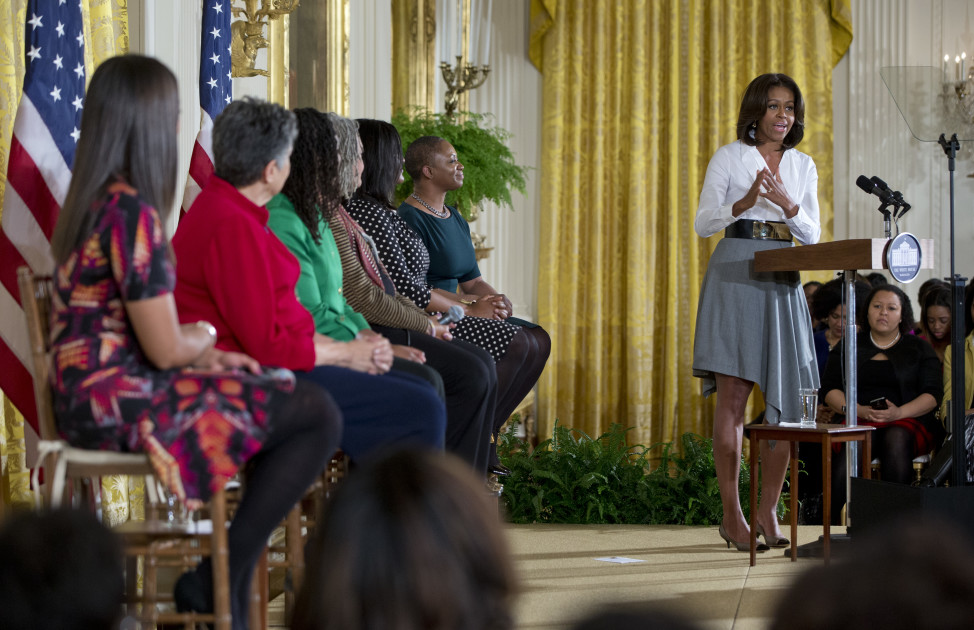
First lady Michelle Obama, right, speaks at the White House in Washington, Feb. 20, 2015, during an event commemorating Black History Month. (AP Photo)
Every year in February, the United States commemorates the achievements of black Americans.
In 2013, there were more than 38 million black Americans, a 74 percent increase since 1970. The population is expected to grow to more than 55 million by 2060, according to the Pew Research Center.
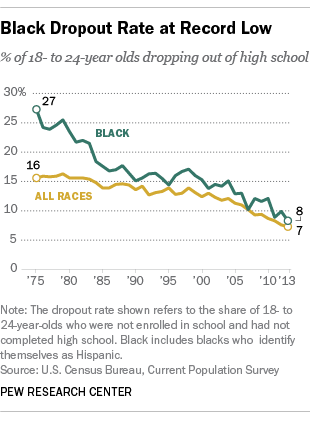 In honor of Black History Month, Pew has put together the following facts:
In honor of Black History Month, Pew has put together the following facts:
1) High school dropout rates have declined faster among blacks ages 18 to 24 than the national average.
The rate has dropped from 24 percent in 1976 to 8 percent in 2013, according to Pew.
Meanwhile, the percentage of blacks graduating from college rose faster than the national average.The share of those 25 and older with at least a bachelor’s degree has increased from 7 percent in 1976 to 22 percent in 2013.
The national average rose from 15 percent to 32 percent over the same time period.
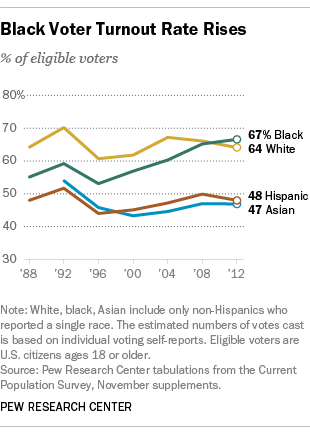 2) The black voter turnout rate exceeded that of whites–66.6 percent to 64.1 percent–in the last presidential election for the first time ever.
2) The black voter turnout rate exceeded that of whites–66.6 percent to 64.1 percent–in the last presidential election for the first time ever.
In 2004, which was the last presidential election without Barack Obama on the ballot, the white voter turnout rate surpassed that of black by 67.2 percent to 60 percent. According to Pew, the turnout gap between whites and blacks has been closing over time.
3) About 6 million blacks left the South between 1910 and 1970 to move to other parts of the country in what has become known as the Great Migration.
However, the trend has reversed since then, partly due to the decline of industrial jobs in the north, according to the Brookings Institution.
The black population increased by about 10 million in the South from 1970 to 2010, and just 6 million in the rest of the country.Today, more than half of the country’s black population–57 percent–lives in the South. That’s up from 52 percent to 1970.
According to Pew, blacks are the largest nonwhite racial or ethnic group in 13 southern states and the District of Columbia. In those states, the black population is at least twice that of Hispanics.
4) The poverty rate among blacks is the highest of any racial or ethnic group, but has declined slightly over time.
The black poverty rate declined from 31.3 percent in 1976 to 27.2 percent in 2014, according to census data.
Meanwhile, the overall U.S. poverty rate has increased from 12.3 percent in 1976 to 14.9 percent in 2014. In addition, blacks fare worse than other groups when it comes to wealth. In 2013, the median wealth of white households was $141,900, 13 times the median wealth of black households at $11,000.
That’s the widest gap since 1989, according to a Pew Research analysis of Federal Reserve survey data.
5) President Obama is the most important black leader.
In 2011, two-thirds of black people said Obama was the most important black leader in the United States, according to a Washington Post poll.
About 7 percent named Martin Luther King Jr., and 16 percent offered no opinion. Jesse Jackson was the top choice in previous decades, according to various surveys.
6) Blacks are more likely than whites to say a lot needs to be done to achieve racial equality in the U.S.
In a 2013 Pew Research survey, 79 percent of blacks and 44 percent of whites said a lot needs to be done to achieve racial equality in the United States. Eight percent of blacks and 17 percent of white said a little or nothing needs to be done.
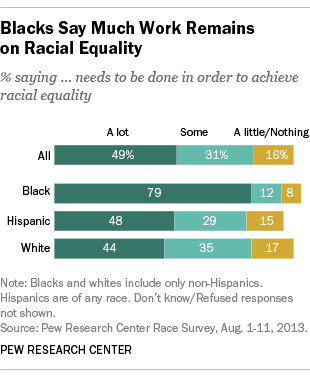

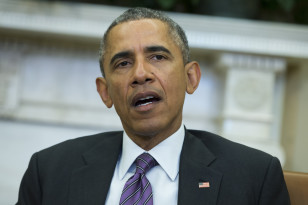





















Oh, I have some interesting facts about black Americans. Sorry, not going there with the whole African-American farce, since most blacks care less about Africa or Africans. The following facts are about either Democrats or Republicans, see if you know your black history:
1. Enforced slavery.
2. Fought and died to keep slavery. (Civil War)
3. Passed and enforced Jim Crow laws. Killed all ethics bills that made slave abuses a crime.
4. Passed and enforced segregation.
5. Registered members formed the KKK. Affiliated with this other party, then you weren’t allowed to join the KKK. Which party?
6. Several sitting presidents of this party refused to recognize most blacks with Medals-of-Honor, who actually earned them.
7. This party fought for and passed a single legislation that has murdered more blacks than all wars combined. Which one?
8 Used Christian coalitions and the bible to justify slavery. Which president realized the necessity of church and state seperation because of this?
All 8 of these facts are referring to the party that most blacks associate themselves with and vote for…..the Democratic Party! The answer to #5 is the Republicans. The answer to #7 is Abortion. The answer to #8 is President Lincoln, and this can be found in his presidential diary. In no way implying that blacks should be Republicans, since both parties seem to be highly disappointing. But Democrats? I’m confused. Democrats owned the Dirty South 100% until the 1970’s. Remember, the worst racial tensions in the South was with 100% Democratic control. When blacks got their rights, they should have destroyed the Democratic Party altogether and rebuilt a new party that represents all! That would have made sense!
Yes, one world, Democrats! Blacks in America jumped all into the Democratic Party and turned it inside out. All those Dirty South Democrats had to jump ship and leave the party when the Blacks signed up. Those Dirty South folks exited the party and formed their DixieCrats while the others joined the Republicans….and here we are today. Just let a Republican hit the political stage trumpeting and standing up for the rights of Gays, of Women Equality, Ending the War on Drugs, Legalizing Recreational Marijuana, Higher Minimum Wage, Reasonable Immigration Reform, Single Payer Healthcare, Legal Abortion Up To 20 Weeks, Ending Citizen’s United, Green Energy….and watch Black Americans and many more flood the Republican party.
That’s not an argument – the base of the Democratic Party then has swung over to the Republican side of today. It’s not about the party, it’s about its voting base. Go back and learn your US history.
If you only knew how idiotic that comment sounds. That like saying a Steakhouse has jumped over to the Vegetarian side! Why not change the name then? That’s the whole point here, or were you paying attention? It’s the fact of what the Democratic Party did furiously, in its most recent past, commit atrocities against minorities that this party should not exist anymore, much less black people embrace it. Do black people embrace the KKK? What’s the difference! Black people still haven’t forgiven whites for slavery, even though the precious Arabs started black slavery first, before the Europeans did. In fact, a black man, Anthony Johnson, introduced and got permission to start the slave trade in the Americas! He actually went to court to sue to start slavery! But black people embrace Islam, the original slavemaster religion! If Nazis included Jews, do you think that any Jew would join up with that party???!!!! That’s the point here, doesn’t matter if the Democratic Party has changed its ways, it’s the fact that why would blacks trust that devil party to begin with???!!!!!! Can a black person please answer this question?
As vjdeejay already pointed out, the parties have shifted since slavery. A Lincoln republican is not the same as a modern republican. The south fought tooth and nail to keep slavery, segregation, and repress black rights. Now those southerners overwhelmingly support the Republican party which is back to the old tricks of voter suppression this time via voter ID laws, which solve the NON-EXISTENT problem of voter fraud (2,068 alleged election-fraud cases since the year 2000 out of hundreds of millions of votes) and repress voters without photo ID that just happen to tend towards voting Democrat.
One World, if you can’t figure that out simply because the parties haven’t changed their names for hundreds of years, then you need to stop commenting.
Voter ID laws are NOT discriminatory, it makes sense to have to proove who you are, and that your a United States citizen. Anyone who can’t get to the DMV with 20 bucks for an ID does not deserve to vote in my opinion.
According to colonial records, the first slave owner in the United States was a black man.
Prior to 1655 there were no legal slaves in the colonies, only indentured servants, mostly white or European. All masters were required to free their servants after their time was up. Seven years was the limit that an indentured servant could be held. Upon their release they were granted 50 acres of land. This included any Negro purchased from slave traders. Negros were also granted 50 acres upon their release.
Anthony Johnson was a Negro from modern-day Angola. He was brought to the US to work on a tobacco farm in 1619. In 1622 he was almost killed when Powhatan Indians attacked the farm. 52 out of 57 people on the farm perished in the attack. He married a female black servant while working on the farm.
When Anthony was released he was legally recognized as a “free Negro” and ran a successful farm. In 1651 he held 250 acres and five black indentured servants. In 1654, it was time for Anthony to release John Casor, a black indentured servant. Instead Anthony told Casor he was extending his time. Casor left and became employed by the free white man Robert Parker.
Anthony Johnson sued Robert Parker in the Northampton Court in 1654. In 1655, the court ruled that Anthony Johnson could hold John Casor indefinitely. The court gave judicial sanction for blacks to own slave of their own race. Thus Casor became the first permanent slave and Johnson the first slave owner.
Whites still could not legally hold a black servant as an indefinite slave until 1670. In that year, the colonial assembly passed legislation permitting free whites, blacks, and Indians the right to own blacks as slaves.
By 1699, the number of free blacks prompted fears of a “Negro insurrection.” Virginia Colonial ordered the repatriation of freed blacks back to Africa. Many blacks sold themselves to white masters so they would not have to go to Africa. This was the first effort to gently repatriate free blacks back to Africa. The modern nations of Sierra Leone and Liberia both originated as colonies of repatriated former black slaves.
However, black slave owners continued to thrive in the United States.
By 1830 there were 3,775 black families living in the South who owned black slaves. By 1860 there were about 3,000 slaves owned by black households in the city of New Orleans alone. Now let’s see how many black people know their true roots.
This comment appears to me to be a simple case of cherry picking data in an attempt to alleviate white guilt.
Your numbers are missing an important thing, context. In 1830 about 13.7% of the black population was free. Of those, 3776 free black people owned 12907 slaves. That’s out of a total of 2,009,043 slaves in the entire USA. ie 0.6% of slaves were owned by free black people. 0.6%.
Now lets break that down more: 42% of black slave owners owned just 1 slave, and 94% of black slave owners owned between 1 and 9 slaves. There is a reason for this: a large portion of these free black slave owners purchased their wife or family members to protect them from being captured and resold into slavery, which was much harder for them to do when someone else could claim ownership.
Back to adding context, since only 0.6% of slaves were owned by free black people, that means that an overwhelming majority of 99.4% were owned by non-black slave owners. Not to mention that the overwhelming majority of these slaves were black. So don’t try to shift the blame for slavery to black people, they were the VICTIMS of slavery. Period.
Here is a personal word of advice to you: Don’t try to blame black people for slavery, and especially don’t try to blame them in an article presenting facts for black history month. This is racist and extremely offensive. Blaming black people for slavery is even more offensive than people who blame the victims of rape in articles about rape. I strongly advise you to stop trying to teach your version of black history, you’re being racist and extremely offensive.
Really? Racist? Maybe my black wife doesn’t think so! Who is proud to call herself black, and not African-American! The point here is not placing blame on anyone, but she is also tired of historical distrotion that does place all blame on white people! It is a shared responsibility, and not presenting all the facts, regardless of percentage, is simply wrong by all accounts. You can’t simply say that the Democrat party is now the Republican party just because black people love the Democrat party, that’s just insane to believe. The Democrat Party shouldn’t exist anymore, period. She, as well as I, can’t understand why black people haven’t sought after their own party since civil liberties were given. The Republican party is garbage, and it IS the party of Lincoln. The Republican party freed the slaves, but why didn’t either party give blacks their rights until 100 years later? See what I mean. It’s pure historical distortion and the blacks that HAVE suffered and had the REAL struggles in our nation deserve better honors during black history month than to have their race affiliated with the slavemaster party of the Democrats! Funny that you call it cherry picking, when you just did the exact same thing. You didn’t cherry pick that 99.37% of the people who died for blacks to have their freedoms were white and 0.29% that died for blacks to have their freedoms were black, the rest is of other races, including Native Americans. You see, my mother-in-law is a retired school teacher. It’s because of her that my views about history are such in depth, she is amazing with the best way to understand the limited history our children receive. She has impressed upon others, especially black kids, that they should honor their ancestors and the importance that slavery had to the success of this great nation, not to be angry, but proud! She impressed to me that without the African slavery, the US may not even exist today, because, slavery amassed great wealth for the colonies to be able to defeat the most powerful empire on earth. Like I said, an amazing woman.
Hopefully, you will someday understand that the Democrat party will not allow schools to impress upon black people that they need to be proud of their ancestors, not just to be angry about it. Funny how that you didn’t even know if I am white or black when you called me racist. The information that I shared was by a black historian herself! She is not alone, even as a retired teacher, she still continues her plight to get black people out of the blame game, and out of the party that plays the blame game as well. Nothing good comes from constantly blaming someone or another races for one’s failures. Even now that the current prez is a black man, he has yet to take responsibility for any of his failures, and places blame on Republicans. You will be surprised how many blacks I have met in my life that don’t care for black history month, they consider it insulting and another tool by the Democrats to keep the races seperate and not united.
Really? You’re going to pull the old “I’m not racist because my wife is black”? So what? My girlfriend is black too and she would have also told you to come correct. But ultimately that doesn’t matter because I can’t prove that and neither can you. You can’t hide behind your black wife or your retired teacher mother-in-law because they didn’t write those comments, you did. You found an article that tries to show progress “in honor of black history month” (i’m not defending the article itself since i don’t think it’s particularly well done) and you decided to basically say “no that’s not black history, black people owned slaves too and are partially responsible for their own slavery, that’s black history”. No, this is not the place for that, that is offensive and uncalled for. You are providing tid-bits of information for racists who may read your comments to memorize and use to justify their own racism. No, I will not let it slide, you are being offensive and adding fuel to racism.
If you think I cherry picked data then you need to look up the definition. You cherry picked data by showing that some black people owned slaved without showing that they actually only owned 0.6% of slaves, a nearly negligible proportion. A number alone is not enough, it needs context or else an out-of-context number can be used to try to prove anything. I didn’t cherry pick any data, I fact checked the data that you presented. You can ask your mother-in-law what fact checking means.
As for your ramblings about Democrats and Republicans, I’m not even go to touch that because it’s just so non-nonsensical that it’s not worth my time trying to decipher it. I will only point out that some black American’s did try to form their own political party, it was called the Black Panther Party but it didn’t work out for various reasons that you can ask your mother-in-law to teach to you. Ultimately it is just not all that simple in a deeply rooted 2 party system.
Yeah, and just beacuse a man is married to a woman doesn’t mean that he can’t be gay, I get it. The point is. as long as we have Black History Month, Black entertainment media (BET, Jet, Ebony, etc), Black Miss America, Negro college fund, Affirmative Action, Black military awards (where they don’t have any White military awards or other minority awards) then there will always be tools to foster racism, such as people like you. Regardless of these irrelevant (proportional) figures you give, you forgot the most important issue here: because Anthony Johnson IS the reason that the African slave trade became popular in the colonies! The colonial leaders at that time didn’t want Africans in their colonies, and YES, due to racial reasons. White Europeans were the choice at that time because they had work, food, and a place to sleep, unlike in Europe. Plus when their servitude was done, they easily blended into the colonial society. The Vanderbilts are a perfect example of what I am talking about here. So NO, white people aren’t responsible for slavery in the US, they are responsible for participating and took responsibility for that (Civil War!). See if your pea-brain can finally understand what my BLACK mother-in-law opened my eyes to, I had no idea about these views until she expressed them to me. Anthony Johnson was so successful with his African slave plight, that he proved that Africans were better laborers than European indentured servants. Plus, African slaves were easier to manage than white servants. He proved that that uncivilized people such as Africans were easier to train (like dogs!!!). The point about Black History Month is that the history is washed and gently cleansed to be sensitive to this ‘struggle’ that black people have no idea what the true struggle is……..THEMSELVES! Her other point is that she is sick of the race card being played today and that no other nation in the world has sacrificed 100’s of thousands of lives for black people, NO OTHER NATION! The most important reason that she expressed all these facts to me is because she wanted me to find a way to feel comfort among black people, and not to ever feel this ‘white guilt’ that the Democrats foster just to appeal to the black voter base. You seem to not understand that the Democratic party is vital to Black History Month and what this party has done to black people. Should not have mentioned the BPP, of course I already knew that! The BPP was a militant and criminal organization for black domination. My point was for black people to help establish a party for all of us! Both parties are not ‘for the People’, they are for their respective parties only!
Oh yeah, and one more thing. I am glad to be having this conversation with you, irritating, but nice to talk about it. That’s why I love my country truly!
Been to Africa, several times. No, not by choice, because of the job I do. But glad to go, that’s for sure. Met so many REAl Africans there and they are not like black people back home. Several have commented to me that they are against black people calling themselves African-American and not calling themselves black. Africans can’t understand this about blacks in America. They say that most American blacks don’t care about Africa or Africans. Most American blacks don’t even care to find thier African roots. They say that African-Americans should be called Lucky-Americans. Yeah, they refer to blacks in America as the lucky ones. Of course they were referring to slavery but we know that the ‘ends’ never justify the ‘means’. Now, again about the Civil War and why I keep mentioning this, and it is not expressed during Black History Month!!!! Not only did 100’s of thousand of WHITES die to end slavery, but the entire concept of the United Staes of America was sacrificed to end slavery as well. That’s right, the nation you and I love dearly was sacrificed as well to end slavery! Even yourself wanted me to be sensitive to blacks during Black History Month when this is a sensitive subject year round! Her last point is that black people that ride that ‘struggle’ train to get thier way are shameful, and having ‘black’ only enterprises was NOT what Dr Martin Luther King, Jr fought for!!!!!